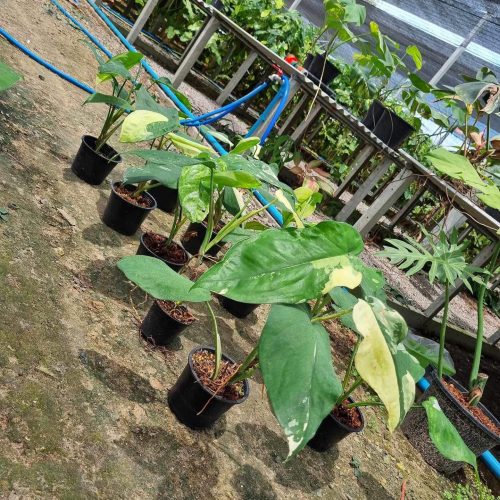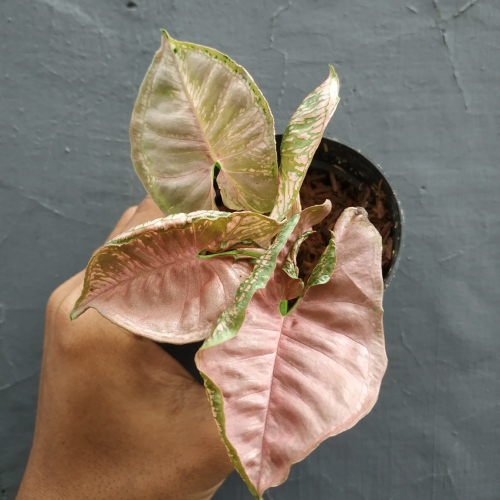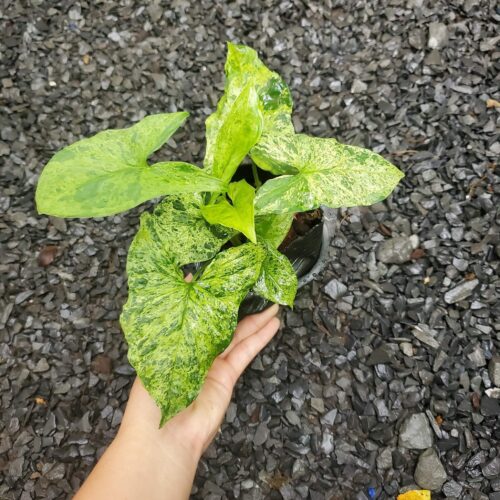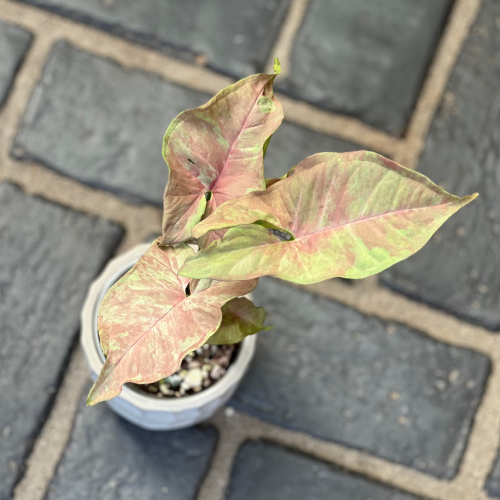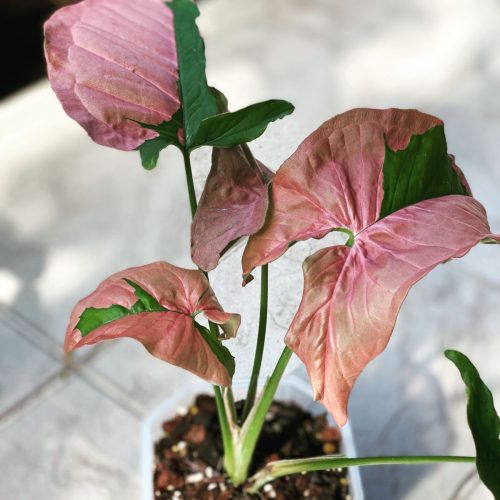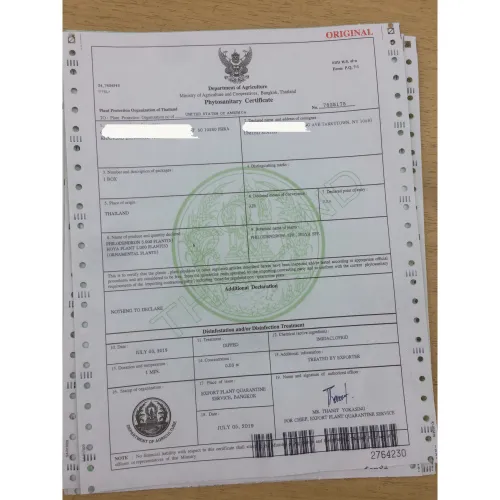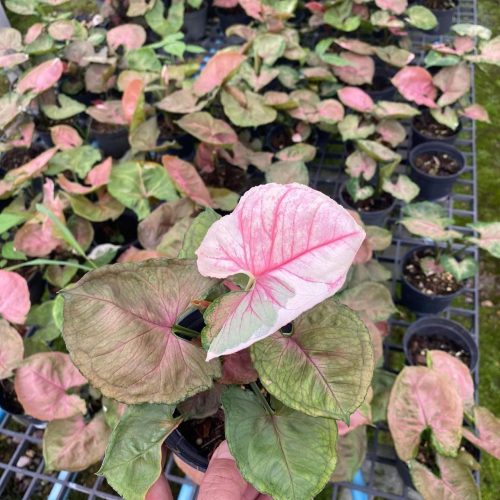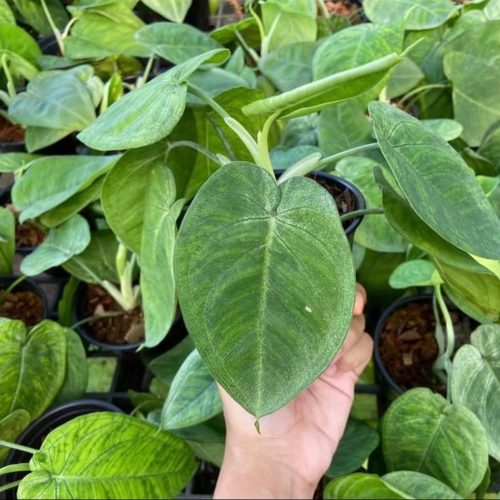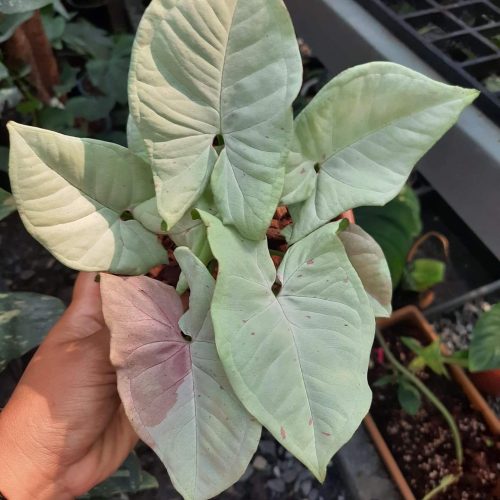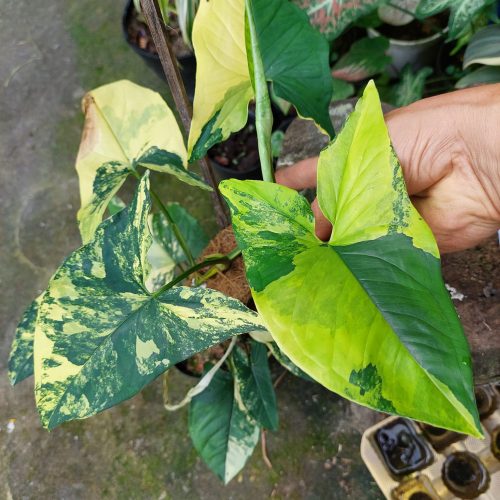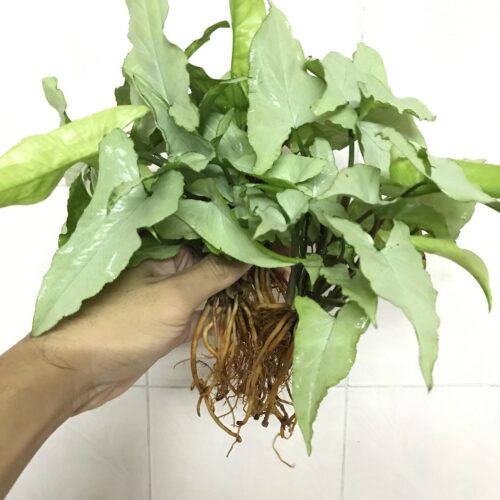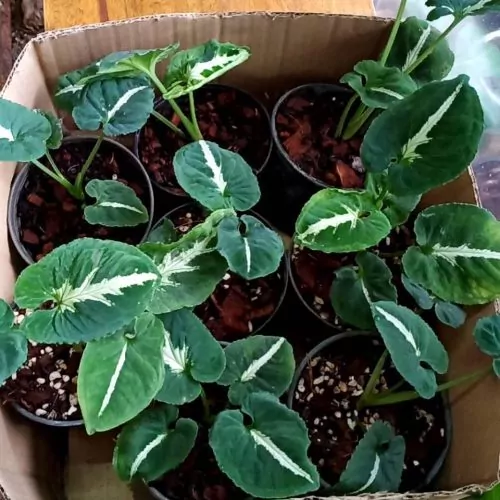The Syngonium Frosted Heart is a gorgeous variety of arrowhead plant adored for its stunning foliage. This easy-care houseplant features leaves variegated in shades of pink, white, and green that give it a delightful frosted heart appearance.
Overview
The Syngonium Frosted Heart, also referred to as the Arrowhead Frosty Heart plant, is an eye-catching cultivar in the Araceae family. This climbing aroid is native to tropical rainforests in Latin America and has made its way into homes and offices as an easy-to-grow indoor plant.
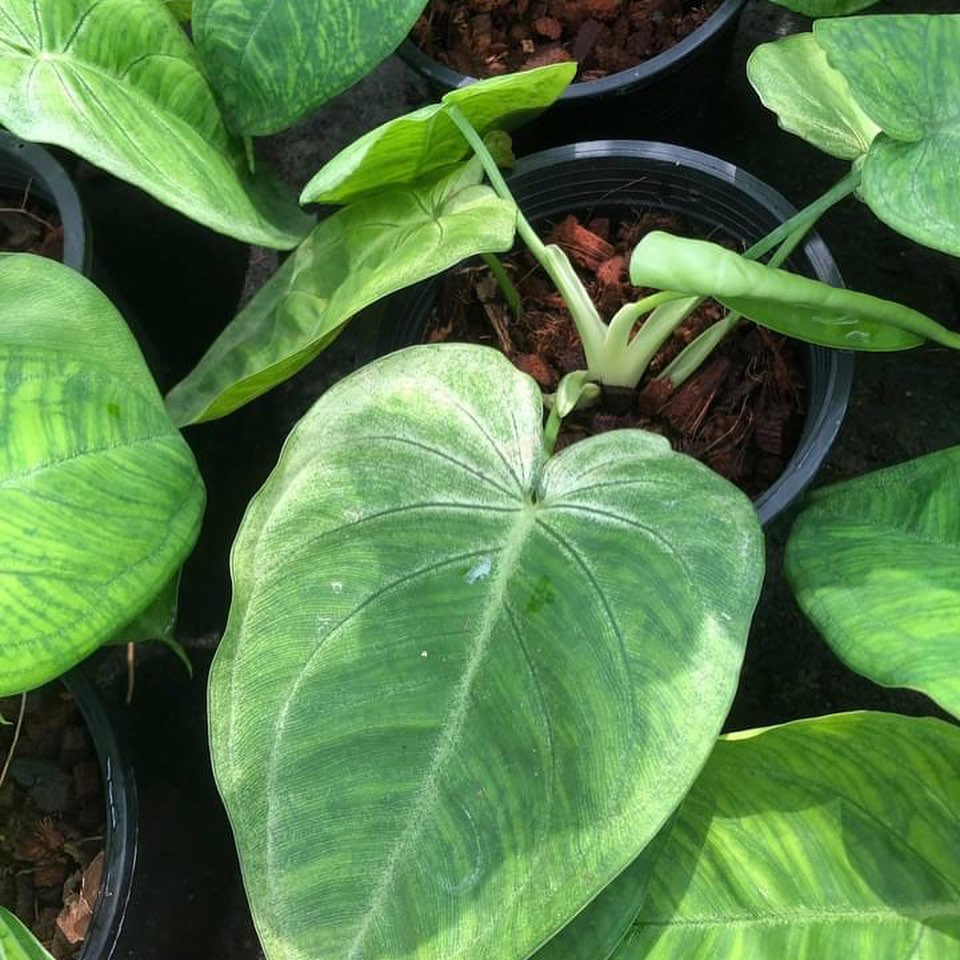
Description
Syngonium Frosted Heart plants have trailing vines with green stems and unique trilobate-shaped leaves in frosted shades of pink, white, and green. The vibrant variegation occurs along the edges and central veins of each mature leaf, creating pretty frosted heart patterns. When young, the leaves first emerge in a solid pink color before transitioning to their frosted tricolor as they mature.
This Syngonium variety is a smaller, more compact type, reaching just 1 to 3 feet in height. It spreads readily via its trailing vines that look beautiful spilling from a hanging basket. Its foliage provides great texture and color to indoor spaces year-round.
Cultivars
There are a few cultivars of Arrowhead Frosty Heart available beyond the classic tricolor frosted type:
- Syngonium ‘Pink Frosty Heart’ – Very similar to classic frosted heart but with darker pink leaves
- Syngonium ‘Jade Frosty Heart’ – Light green leaves edged in dark green with frosted centers
- Syngonium ‘Golden Frosty Heart’ – Chartreuse leaves with frosted white centers
While most cultivars share a similar look, the Pink Frosty Heart tends to be the most common type found for sale.
“Explore a wider variety of Syngonium cultivars and their unique characteristics in our detailed guide to Syngonium Types: 5 Stunning Syngonium Varieties.”
Care
Caring for a Syngonium Frosted Heart houseplant is quite straightforward. This tropical aroid thrives indoors with bright light, average room temperatures, and weekly waterings.

“Discover the elegance of nature with the Syngonium Frosted Heart – a stunning addition to your home! Click now to embrace its beauty and transform your space. Shop today!”
Light
The Frosted Heart Arrowhead prefers bright, indirect sunlight for best growth and to maintain its fabulous foliage colors. East or west-facing windows work perfectly. Some direct morning sun is ok, but afternoon sun can scorch its leaves. Low light will cause slower growth and greener foliage over time.
Water
Water your Syngonium deeply whenever the top inch or two of soil has dried out. Allow the pot to drain fully after saturating and never leave this plant sitting in water, which can lead to root rot. In general, a thorough watering about once per week is sufficient. Reduce water slightly in winter during its dormant period.
Temperature & Humidity
Syngoniums grow well in average room temperatures around 65-80°F and moderately humid environments around 40-50% humidity. Keep away from cold drafts or dry air from heaters to prevent leaf damage at the margins. Use a pebble tray or room humidifier to boost moisture if needed.
Soil
A well-aerated, loose potting mix works great for Frosted Heart Arrowhead plants. A general houseplant soil amended with perlite, bark chips, or orchid mix keeps the soil from compacting too much while still retaining some moisture. Allowing the soil to dry out moderately between waterings is key.
Fertilizer
Feed monthly in spring through fall with a balanced liquid fertilizer diluted to half strength. This provides nutrients for growth and nice foliage variegation. Cease fertilizing over winter when light and growth slow down.
Support
As a climbing aroid vine, the Frosted Heart Syngonium does best when given some type of moss pole, trellis, or stake for support. This allows the stems to naturally vine upwards. Smaller plants can trail along in hanging baskets. Pruning is optional to keep its size in check.
Where to buy Syngonium Frosted Heart? Benefits from importing plants from Thailand
- Shipping: Door to door shipping, fast and safe with Dragon Courier
- Biodiversity: Thailand is known for its rich biodiversity, including a wide variety of aroid species. This diversity allows importers to access a broad range of unique and exotic aroid plants.
- Quality and Health of Plants: The suitable climate helps the plants grown here stay healthy and of high quality.
- Cost-Effectiveness: Due to favorable growing conditions and efficient production methods, Thai aroid plants can often be more cost-effective compared to those from other countries.
- Access to Hybrid Varieties: Thai growers are often involved in the development of new hybrid aroid varieties, offering unique plants that may not be available from other sources.
Syngonium species are the most sought after by aroid plant lovers
Propagation
Propagating Syngonium Frosted Heart plants is quite simple! Just take stem cuttings with a few nodes, remove lower leaves, and place in water or moist potting mix. New roots will sprout within a few weeks, allowing the cutting to be potted up.
Stem Cuttings
Taking 3-6 inch stem cuttings in spring and summer is the easiest approach. Cut just below a node and remove lower leaves. Place the cutting stem-side down in water or moist potting mix. New roots and baby leaves will begin growing soon. Transition to soil once rooted.
Division
Mature Frosted Heart Syngoniums can be divided by gently teasing the rootball apart and repotting sections with some roots attached into separate pots. Water well initially and new growth will take off. Choose smaller offshoots for repotting over larger stems.
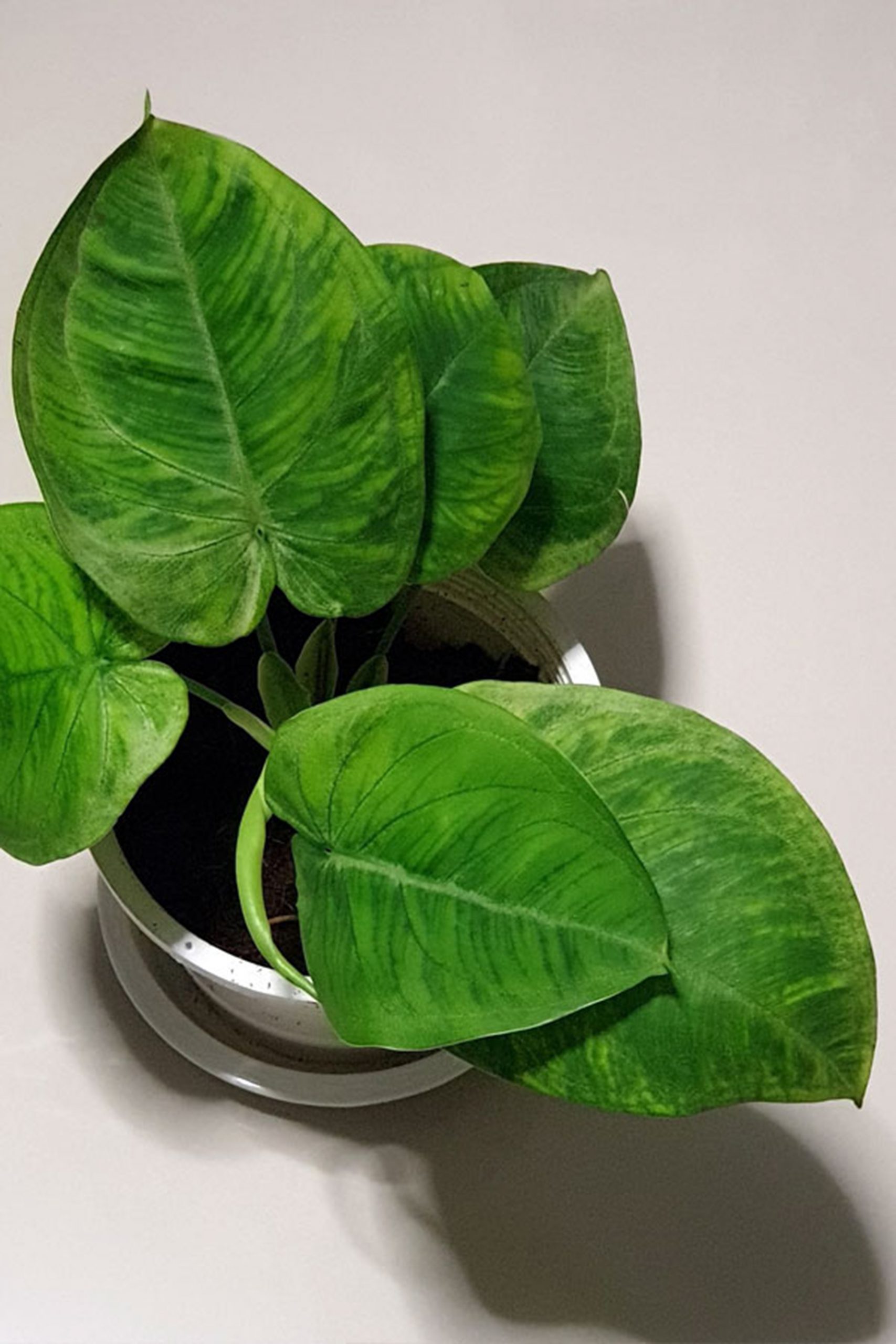
Common Issues
When grown in the proper conditions, Syngonium Frosted Hearts are generally robust, trouble-free houseplants. But there are a few potential issues to watch for:
Drooping Leaves
If your Arrowhead plant’s leaves start drooping, it likely needs more water. Feel the soil and water thoroughly if dry. Low humidity can also cause temporary leaf drooping until conditions improve.
Leaf Spotting
Yellow or brown spotting on the leaves indicates either too much direct sun or improper watering. Move to a shadier spot and alter watering to fix. Good air circulation also prevents bacterial or fungal leaf spots.
Leggy Growth
If your plant becomes sparse and leggy with fewer leaves along the vine, it likely needs more light. Move it closer to a bright window (no direct sun) to encourage bushier growth. Turn the pot periodically so all sides get light exposure.
Conclusion
With its exquisite frosted heart-patterned leaves in shades of pink, white and green, it’s easy to see why the Syngonium Frosted Heart has become so popular. This easy-going vining aroid rewards proper care with fabulous color and visual interest indoors. Provide bright indirect light, average room temperatures, weekly watering, and humid conditions for your Arrowhead Frosty Heart to thrive happily in your home for years to come!
FAQ
- What is a Syngonium Frosted Heart?
- The Syngonium Frosted Heart is a tropical houseplant known for its heart-shaped leaves and striking frosted, silvery-green foliage. It’s a variant of the Syngonium species, popular for its low maintenance and air-purifying qualities.
- How do I care for my Syngonium Frosted Heart?
- To care for a Syngonium Frosted Heart, provide bright, indirect light, water when the top inch of soil is dry, and maintain a humid environment. Avoid direct sunlight and overwatering. Regular misting or a pebble tray can help increase humidity.
- Is the Syngonium Frosted Heart toxic to pets?
- Yes, the Syngonium Frosted Heart is toxic to pets if ingested. It can cause irritation to the mouth, lips, and throat. It’s recommended to keep this plant out of reach of pets and children.
- How often should I water my Syngonium Frosted Heart?
- Water your Syngonium Frosted Heart when the top inch of soil feels dry, typically once a week. However, the frequency may vary depending on the humidity and temperature of your environment. Always check the soil moisture before watering.
- Can the Syngonium Frosted Heart thrive in low light?
- While the Syngonium Frosted Heart prefers bright, indirect light, it can tolerate low light conditions. However, growth may be slower and the leaves may lose some of their variegation in lower light settings.

